Nursing Management of Fractured Humerus Neck: Presentation and Paper
VerifiedAdded on 2022/08/24
|7
|1846
|14
Presentation
AI Summary
This assignment presents a comprehensive overview of nursing care for fractured humerus neck. It begins with a discussion of the pathophysiology of the injury, including the mechanisms of fracture, potential complications, and the role of neurovascular structures. The assignment then delves into the foundational nursing concepts relevant to orthopedic care, such as biopsychosocial care and family-centered nursing. The role of the registered nurse in both medical and surgical management is emphasized, highlighting evidence-based practices for effective care planning, intervention, and evaluation. The presentation covers pre-operative, perioperative, and post-operative care, including wound management, pain control, and the prevention of complications such as delayed healing. The importance of ethical principles, professional frameworks, and adherence to nursing standards is also addressed. The assignment emphasizes the significance of collaboration with other healthcare professionals, and provides a detailed analysis of the key nursing interventions and assessments required for optimal patient outcomes.
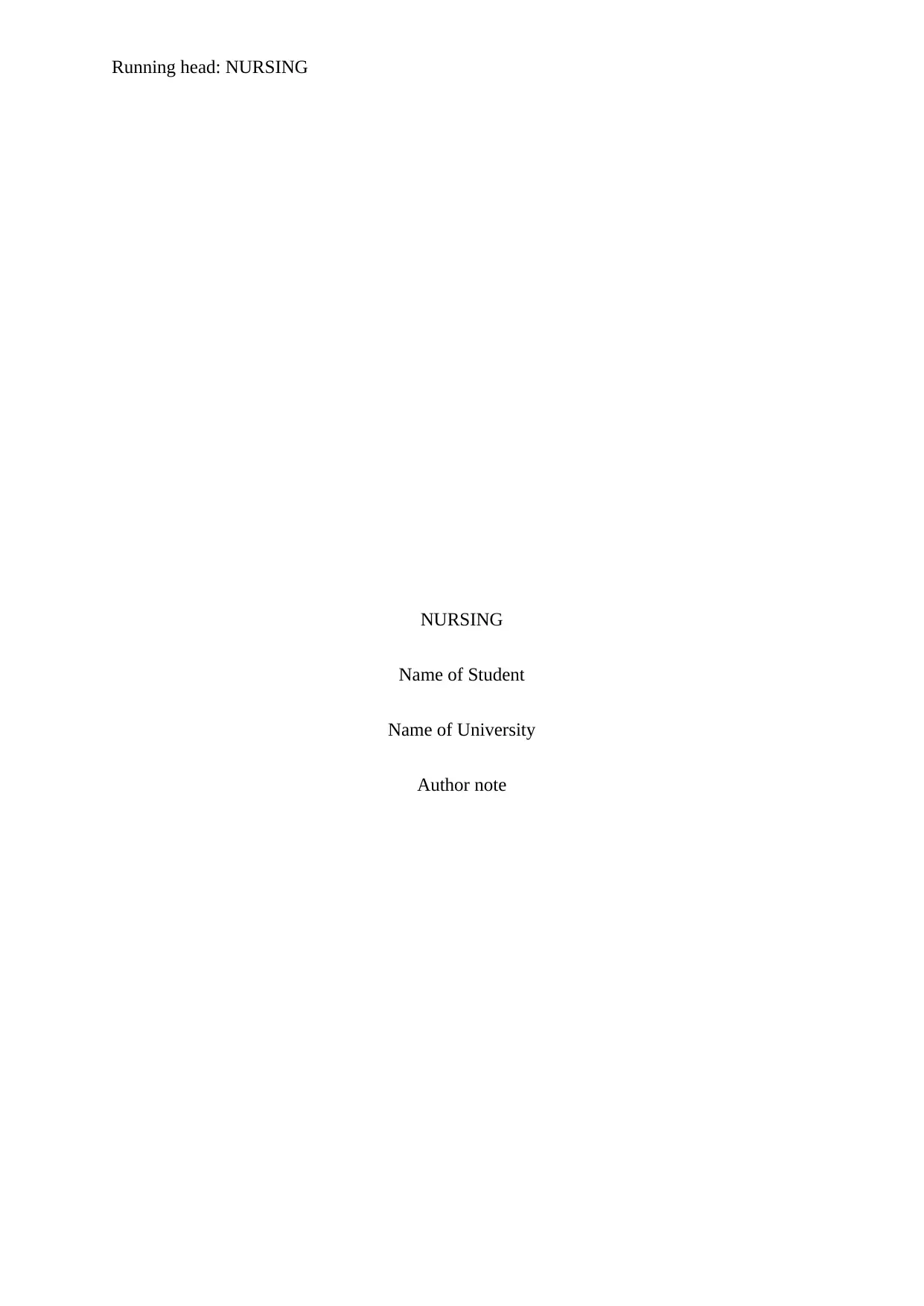
Running head: NURSING
NURSING
Name of Student
Name of University
Author note
NURSING
Name of Student
Name of University
Author note
Paraphrase This Document
Need a fresh take? Get an instant paraphrase of this document with our AI Paraphraser

1NURSING
Humerus fracture is one of the most common injuries and in these type of injuries, not
only the bone but the neurovascular apparatus that is present around the region is sometimes
also fractured in the process (Balzer‐Geldsetzer et al. 2020). By humerus neck fracture, it
means the fracture having occurred in either of the two regions – the surgical neck which the
weakest region in the proximal humerus or the anatomical neck and if there is a
neurovascular injury associated with the humerus neck fracture – it is the axillary nerve that
is mostly fractured (Blandfort et al. 2017). Mostly as far as the pathophysiology of fracture is
concerned, it starts with the etiology of deforming forces being applied to the region resulting
in a fracture of humerus. As an immediate pathophysiological event, pain, spasm (due to
guarding of the surrounding muscles) and swelling occurs and if there is an added blood loss
– there might be an added risk of hypovolemic shock that is also to be intervened separately.
It is important to note that the nature of the fracture – open or closed, displaced or non-
displaced is the major or rather the most cardinal factors that determines the consequent
pathophysiology (Fan et al. 2019). In cases of an open fracture, the pathophysiological
changes might involve the risk of infections or sepsis and in case in fracture neck of humerus,
the blood vessels are severed or disrupted, then impaired blood circulation to the fractured
region can lead to causation of delayed healing and lack of nutrition supply to the area can
also lead to the causation of delayed union of the humerus neck as well. In case, the neural
component of the neurovascular apparatus is involved in injury, then it might lead to the
causation of paresthesia that is the feeling of pins and needles in the concerned area. If the
nerve or rather the neural apparatus is seriously involved in the process – then sensory or
motor symptoms might arise as well. Motor symptoms, if present, would include weakness of
the muscles around the humerus. As a nurse working in the orthopedic setting, it is critical to
understand the pathophysiology of the fracture and when plan the nursing care in pertinence
with the nursing diagnosis and fracture management of the patient. It is highly important to
Humerus fracture is one of the most common injuries and in these type of injuries, not
only the bone but the neurovascular apparatus that is present around the region is sometimes
also fractured in the process (Balzer‐Geldsetzer et al. 2020). By humerus neck fracture, it
means the fracture having occurred in either of the two regions – the surgical neck which the
weakest region in the proximal humerus or the anatomical neck and if there is a
neurovascular injury associated with the humerus neck fracture – it is the axillary nerve that
is mostly fractured (Blandfort et al. 2017). Mostly as far as the pathophysiology of fracture is
concerned, it starts with the etiology of deforming forces being applied to the region resulting
in a fracture of humerus. As an immediate pathophysiological event, pain, spasm (due to
guarding of the surrounding muscles) and swelling occurs and if there is an added blood loss
– there might be an added risk of hypovolemic shock that is also to be intervened separately.
It is important to note that the nature of the fracture – open or closed, displaced or non-
displaced is the major or rather the most cardinal factors that determines the consequent
pathophysiology (Fan et al. 2019). In cases of an open fracture, the pathophysiological
changes might involve the risk of infections or sepsis and in case in fracture neck of humerus,
the blood vessels are severed or disrupted, then impaired blood circulation to the fractured
region can lead to causation of delayed healing and lack of nutrition supply to the area can
also lead to the causation of delayed union of the humerus neck as well. In case, the neural
component of the neurovascular apparatus is involved in injury, then it might lead to the
causation of paresthesia that is the feeling of pins and needles in the concerned area. If the
nerve or rather the neural apparatus is seriously involved in the process – then sensory or
motor symptoms might arise as well. Motor symptoms, if present, would include weakness of
the muscles around the humerus. As a nurse working in the orthopedic setting, it is critical to
understand the pathophysiology of the fracture and when plan the nursing care in pertinence
with the nursing diagnosis and fracture management of the patient. It is highly important to
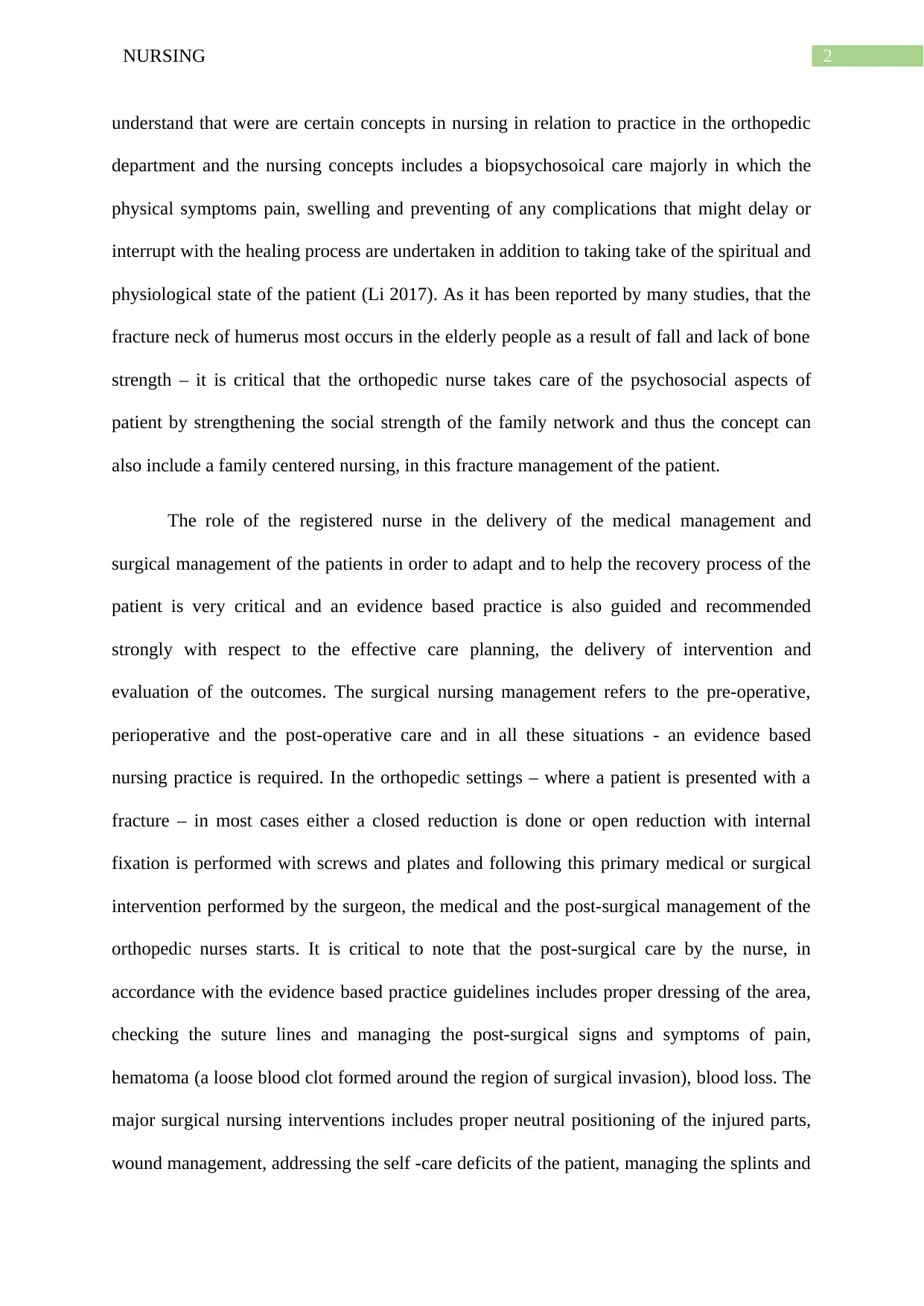
2NURSING
understand that were are certain concepts in nursing in relation to practice in the orthopedic
department and the nursing concepts includes a biopsychosoical care majorly in which the
physical symptoms pain, swelling and preventing of any complications that might delay or
interrupt with the healing process are undertaken in addition to taking take of the spiritual and
physiological state of the patient (Li 2017). As it has been reported by many studies, that the
fracture neck of humerus most occurs in the elderly people as a result of fall and lack of bone
strength – it is critical that the orthopedic nurse takes care of the psychosocial aspects of
patient by strengthening the social strength of the family network and thus the concept can
also include a family centered nursing, in this fracture management of the patient.
The role of the registered nurse in the delivery of the medical management and
surgical management of the patients in order to adapt and to help the recovery process of the
patient is very critical and an evidence based practice is also guided and recommended
strongly with respect to the effective care planning, the delivery of intervention and
evaluation of the outcomes. The surgical nursing management refers to the pre-operative,
perioperative and the post-operative care and in all these situations - an evidence based
nursing practice is required. In the orthopedic settings – where a patient is presented with a
fracture – in most cases either a closed reduction is done or open reduction with internal
fixation is performed with screws and plates and following this primary medical or surgical
intervention performed by the surgeon, the medical and the post-surgical management of the
orthopedic nurses starts. It is critical to note that the post-surgical care by the nurse, in
accordance with the evidence based practice guidelines includes proper dressing of the area,
checking the suture lines and managing the post-surgical signs and symptoms of pain,
hematoma (a loose blood clot formed around the region of surgical invasion), blood loss. The
major surgical nursing interventions includes proper neutral positioning of the injured parts,
wound management, addressing the self -care deficits of the patient, managing the splints and
understand that were are certain concepts in nursing in relation to practice in the orthopedic
department and the nursing concepts includes a biopsychosoical care majorly in which the
physical symptoms pain, swelling and preventing of any complications that might delay or
interrupt with the healing process are undertaken in addition to taking take of the spiritual and
physiological state of the patient (Li 2017). As it has been reported by many studies, that the
fracture neck of humerus most occurs in the elderly people as a result of fall and lack of bone
strength – it is critical that the orthopedic nurse takes care of the psychosocial aspects of
patient by strengthening the social strength of the family network and thus the concept can
also include a family centered nursing, in this fracture management of the patient.
The role of the registered nurse in the delivery of the medical management and
surgical management of the patients in order to adapt and to help the recovery process of the
patient is very critical and an evidence based practice is also guided and recommended
strongly with respect to the effective care planning, the delivery of intervention and
evaluation of the outcomes. The surgical nursing management refers to the pre-operative,
perioperative and the post-operative care and in all these situations - an evidence based
nursing practice is required. In the orthopedic settings – where a patient is presented with a
fracture – in most cases either a closed reduction is done or open reduction with internal
fixation is performed with screws and plates and following this primary medical or surgical
intervention performed by the surgeon, the medical and the post-surgical management of the
orthopedic nurses starts. It is critical to note that the post-surgical care by the nurse, in
accordance with the evidence based practice guidelines includes proper dressing of the area,
checking the suture lines and managing the post-surgical signs and symptoms of pain,
hematoma (a loose blood clot formed around the region of surgical invasion), blood loss. The
major surgical nursing interventions includes proper neutral positioning of the injured parts,
wound management, addressing the self -care deficits of the patient, managing the splints and
⊘ This is a preview!⊘
Do you want full access?
Subscribe today to unlock all pages.

Trusted by 1+ million students worldwide
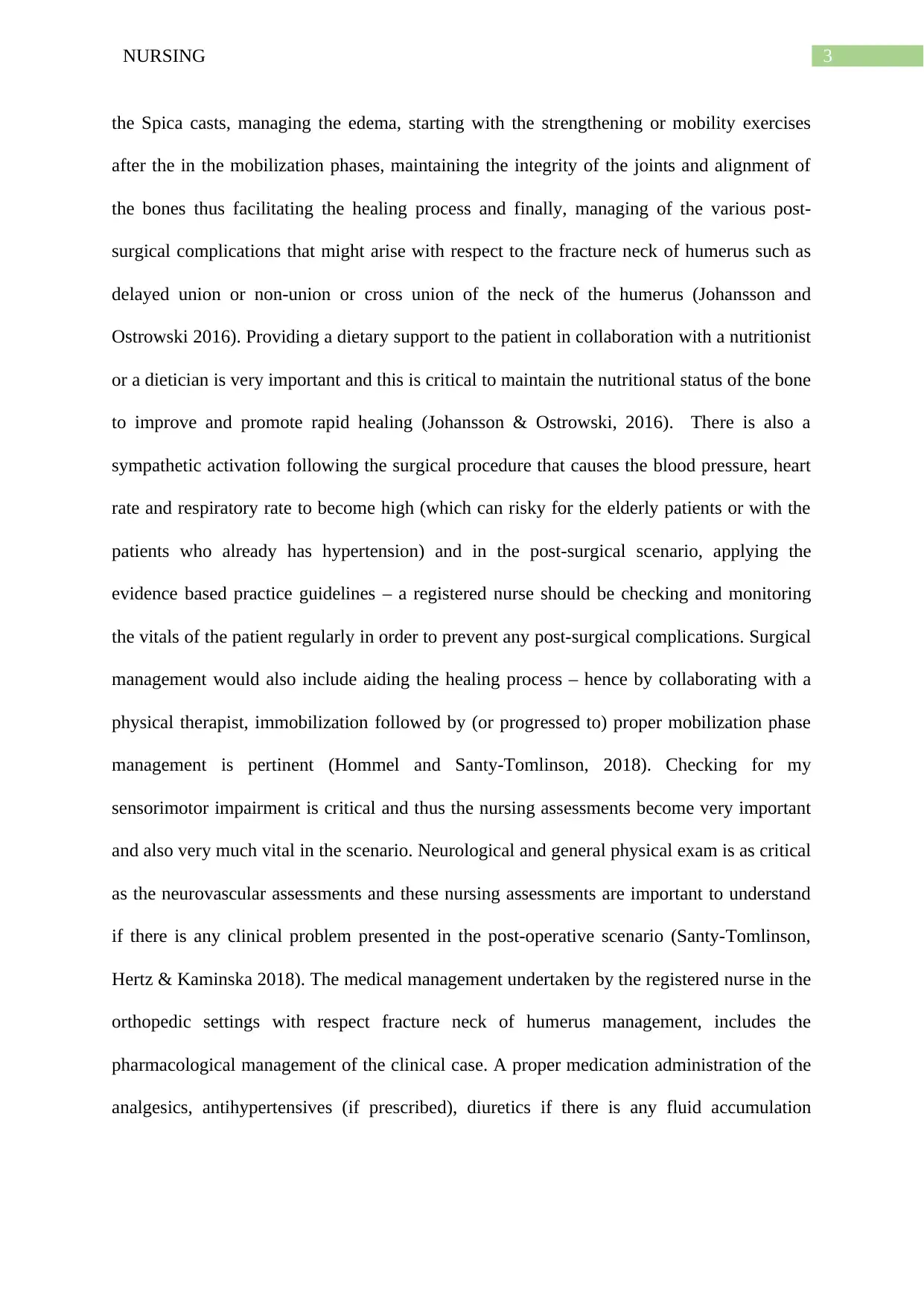
3NURSING
the Spica casts, managing the edema, starting with the strengthening or mobility exercises
after the in the mobilization phases, maintaining the integrity of the joints and alignment of
the bones thus facilitating the healing process and finally, managing of the various post-
surgical complications that might arise with respect to the fracture neck of humerus such as
delayed union or non-union or cross union of the neck of the humerus (Johansson and
Ostrowski 2016). Providing a dietary support to the patient in collaboration with a nutritionist
or a dietician is very important and this is critical to maintain the nutritional status of the bone
to improve and promote rapid healing (Johansson & Ostrowski, 2016). There is also a
sympathetic activation following the surgical procedure that causes the blood pressure, heart
rate and respiratory rate to become high (which can risky for the elderly patients or with the
patients who already has hypertension) and in the post-surgical scenario, applying the
evidence based practice guidelines – a registered nurse should be checking and monitoring
the vitals of the patient regularly in order to prevent any post-surgical complications. Surgical
management would also include aiding the healing process – hence by collaborating with a
physical therapist, immobilization followed by (or progressed to) proper mobilization phase
management is pertinent (Hommel and Santy-Tomlinson, 2018). Checking for my
sensorimotor impairment is critical and thus the nursing assessments become very important
and also very much vital in the scenario. Neurological and general physical exam is as critical
as the neurovascular assessments and these nursing assessments are important to understand
if there is any clinical problem presented in the post-operative scenario (Santy-Tomlinson,
Hertz & Kaminska 2018). The medical management undertaken by the registered nurse in the
orthopedic settings with respect fracture neck of humerus management, includes the
pharmacological management of the clinical case. A proper medication administration of the
analgesics, antihypertensives (if prescribed), diuretics if there is any fluid accumulation
the Spica casts, managing the edema, starting with the strengthening or mobility exercises
after the in the mobilization phases, maintaining the integrity of the joints and alignment of
the bones thus facilitating the healing process and finally, managing of the various post-
surgical complications that might arise with respect to the fracture neck of humerus such as
delayed union or non-union or cross union of the neck of the humerus (Johansson and
Ostrowski 2016). Providing a dietary support to the patient in collaboration with a nutritionist
or a dietician is very important and this is critical to maintain the nutritional status of the bone
to improve and promote rapid healing (Johansson & Ostrowski, 2016). There is also a
sympathetic activation following the surgical procedure that causes the blood pressure, heart
rate and respiratory rate to become high (which can risky for the elderly patients or with the
patients who already has hypertension) and in the post-surgical scenario, applying the
evidence based practice guidelines – a registered nurse should be checking and monitoring
the vitals of the patient regularly in order to prevent any post-surgical complications. Surgical
management would also include aiding the healing process – hence by collaborating with a
physical therapist, immobilization followed by (or progressed to) proper mobilization phase
management is pertinent (Hommel and Santy-Tomlinson, 2018). Checking for my
sensorimotor impairment is critical and thus the nursing assessments become very important
and also very much vital in the scenario. Neurological and general physical exam is as critical
as the neurovascular assessments and these nursing assessments are important to understand
if there is any clinical problem presented in the post-operative scenario (Santy-Tomlinson,
Hertz & Kaminska 2018). The medical management undertaken by the registered nurse in the
orthopedic settings with respect fracture neck of humerus management, includes the
pharmacological management of the clinical case. A proper medication administration of the
analgesics, antihypertensives (if prescribed), diuretics if there is any fluid accumulation
Paraphrase This Document
Need a fresh take? Get an instant paraphrase of this document with our AI Paraphraser

4NURSING
issues, with the blood thinners (in cases of excessive blood clotting problems) is vital to
address the specific problems (Kosar et al. 2018)
As for the nursing principles – the bioethical principles of beneficence, non-
maleficence, informed consent, autonomy, integrity and totality are incorporated in the
surgical and medical management undertaken by the nurses in the orthopedic nurses. It is
highly important and also very critical to understand that the nursing standards as given by
the Nursing and Midwifery board of Australia - is also incorporated imperatively in the
nursing practice (Le Floch, Kermarrec and Gentric, 2019). At first, the nurse must be able to
critical think and clinical reason the case scenario and then engages in proper professional
relationship building with the patient and with other members of the multidisciplinary team,
applies the right self-management skills, properly performs the nursing assessments and
develops the right clinically relevant nursing plan. In addition an orthopedic registered nurse
should also be able to provide a safe, patient centered informed care to the patient and his or
her family and more than importantly, she should demonstrate apt clinical decision making
skills and take full responsibility of her roles and actions.
issues, with the blood thinners (in cases of excessive blood clotting problems) is vital to
address the specific problems (Kosar et al. 2018)
As for the nursing principles – the bioethical principles of beneficence, non-
maleficence, informed consent, autonomy, integrity and totality are incorporated in the
surgical and medical management undertaken by the nurses in the orthopedic nurses. It is
highly important and also very critical to understand that the nursing standards as given by
the Nursing and Midwifery board of Australia - is also incorporated imperatively in the
nursing practice (Le Floch, Kermarrec and Gentric, 2019). At first, the nurse must be able to
critical think and clinical reason the case scenario and then engages in proper professional
relationship building with the patient and with other members of the multidisciplinary team,
applies the right self-management skills, properly performs the nursing assessments and
develops the right clinically relevant nursing plan. In addition an orthopedic registered nurse
should also be able to provide a safe, patient centered informed care to the patient and his or
her family and more than importantly, she should demonstrate apt clinical decision making
skills and take full responsibility of her roles and actions.
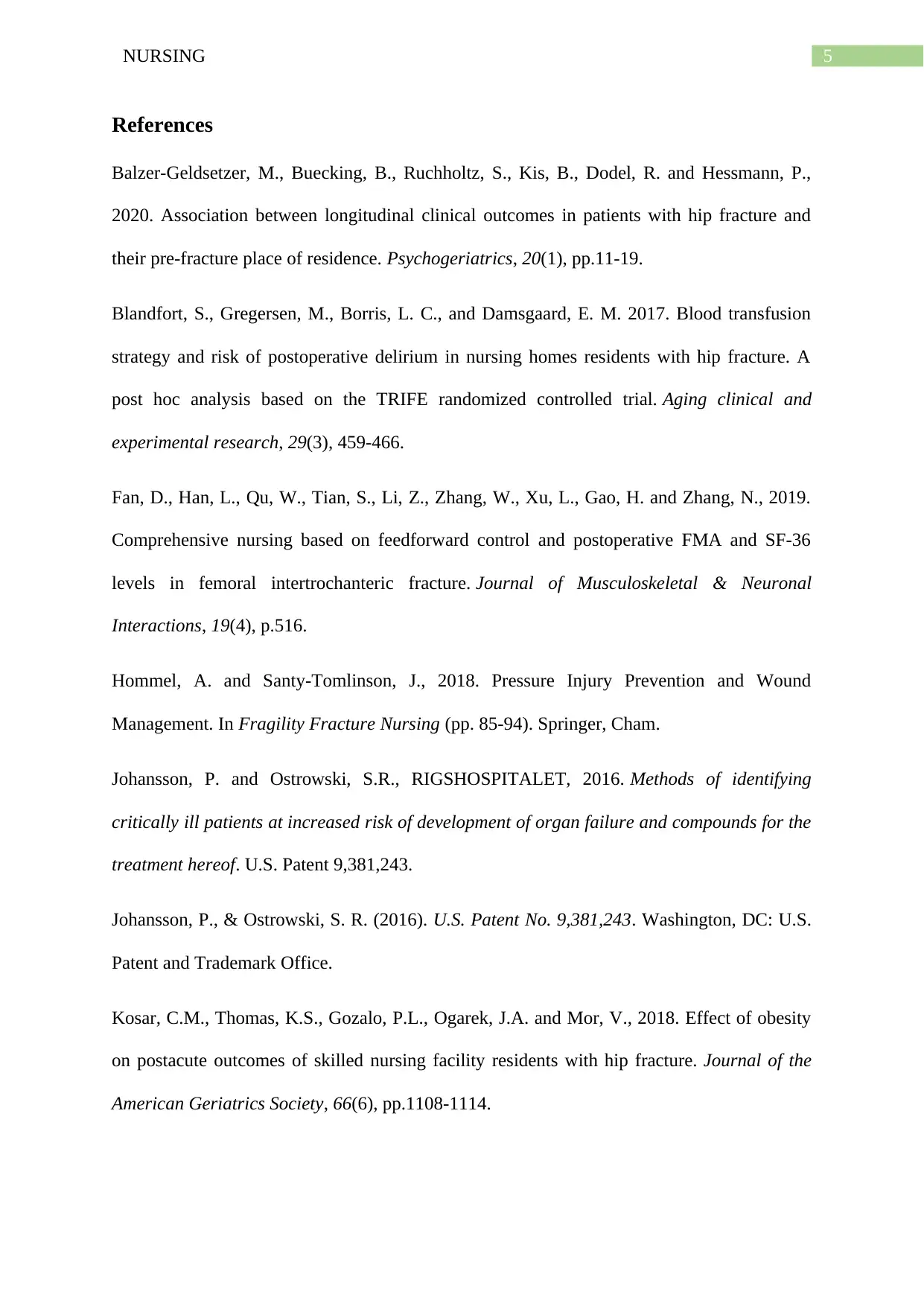
5NURSING
References
Balzer‐Geldsetzer, M., Buecking, B., Ruchholtz, S., Kis, B., Dodel, R. and Hessmann, P.,
2020. Association between longitudinal clinical outcomes in patients with hip fracture and
their pre‐fracture place of residence. Psychogeriatrics, 20(1), pp.11-19.
Blandfort, S., Gregersen, M., Borris, L. C., and Damsgaard, E. M. 2017. Blood transfusion
strategy and risk of postoperative delirium in nursing homes residents with hip fracture. A
post hoc analysis based on the TRIFE randomized controlled trial. Aging clinical and
experimental research, 29(3), 459-466.
Fan, D., Han, L., Qu, W., Tian, S., Li, Z., Zhang, W., Xu, L., Gao, H. and Zhang, N., 2019.
Comprehensive nursing based on feedforward control and postoperative FMA and SF-36
levels in femoral intertrochanteric fracture. Journal of Musculoskeletal & Neuronal
Interactions, 19(4), p.516.
Hommel, A. and Santy-Tomlinson, J., 2018. Pressure Injury Prevention and Wound
Management. In Fragility Fracture Nursing (pp. 85-94). Springer, Cham.
Johansson, P. and Ostrowski, S.R., RIGSHOSPITALET, 2016. Methods of identifying
critically ill patients at increased risk of development of organ failure and compounds for the
treatment hereof. U.S. Patent 9,381,243.
Johansson, P., & Ostrowski, S. R. (2016). U.S. Patent No. 9,381,243. Washington, DC: U.S.
Patent and Trademark Office.
Kosar, C.M., Thomas, K.S., Gozalo, P.L., Ogarek, J.A. and Mor, V., 2018. Effect of obesity
on postacute outcomes of skilled nursing facility residents with hip fracture. Journal of the
American Geriatrics Society, 66(6), pp.1108-1114.
References
Balzer‐Geldsetzer, M., Buecking, B., Ruchholtz, S., Kis, B., Dodel, R. and Hessmann, P.,
2020. Association between longitudinal clinical outcomes in patients with hip fracture and
their pre‐fracture place of residence. Psychogeriatrics, 20(1), pp.11-19.
Blandfort, S., Gregersen, M., Borris, L. C., and Damsgaard, E. M. 2017. Blood transfusion
strategy and risk of postoperative delirium in nursing homes residents with hip fracture. A
post hoc analysis based on the TRIFE randomized controlled trial. Aging clinical and
experimental research, 29(3), 459-466.
Fan, D., Han, L., Qu, W., Tian, S., Li, Z., Zhang, W., Xu, L., Gao, H. and Zhang, N., 2019.
Comprehensive nursing based on feedforward control and postoperative FMA and SF-36
levels in femoral intertrochanteric fracture. Journal of Musculoskeletal & Neuronal
Interactions, 19(4), p.516.
Hommel, A. and Santy-Tomlinson, J., 2018. Pressure Injury Prevention and Wound
Management. In Fragility Fracture Nursing (pp. 85-94). Springer, Cham.
Johansson, P. and Ostrowski, S.R., RIGSHOSPITALET, 2016. Methods of identifying
critically ill patients at increased risk of development of organ failure and compounds for the
treatment hereof. U.S. Patent 9,381,243.
Johansson, P., & Ostrowski, S. R. (2016). U.S. Patent No. 9,381,243. Washington, DC: U.S.
Patent and Trademark Office.
Kosar, C.M., Thomas, K.S., Gozalo, P.L., Ogarek, J.A. and Mor, V., 2018. Effect of obesity
on postacute outcomes of skilled nursing facility residents with hip fracture. Journal of the
American Geriatrics Society, 66(6), pp.1108-1114.
⊘ This is a preview!⊘
Do you want full access?
Subscribe today to unlock all pages.

Trusted by 1+ million students worldwide
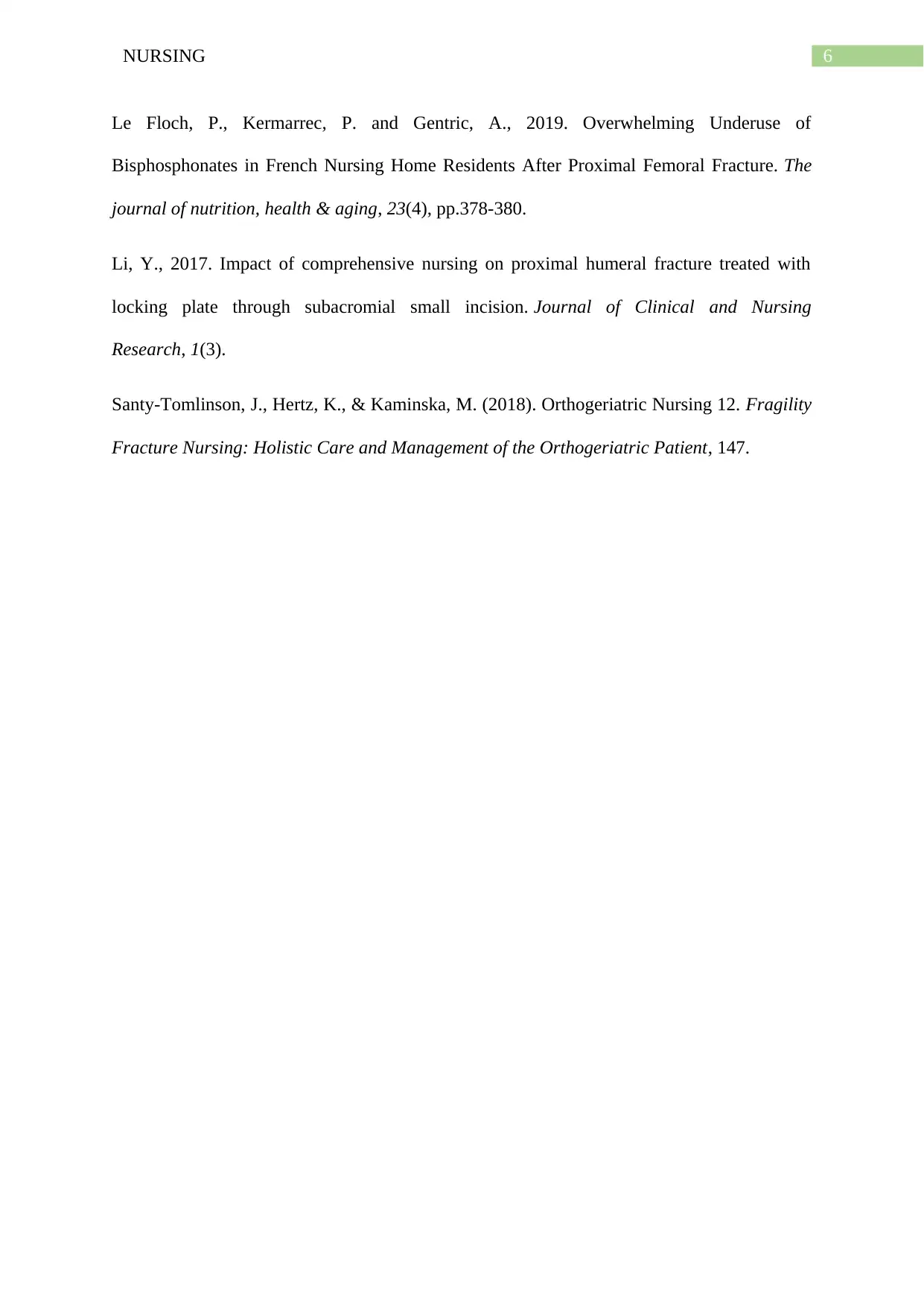
6NURSING
Le Floch, P., Kermarrec, P. and Gentric, A., 2019. Overwhelming Underuse of
Bisphosphonates in French Nursing Home Residents After Proximal Femoral Fracture. The
journal of nutrition, health & aging, 23(4), pp.378-380.
Li, Y., 2017. Impact of comprehensive nursing on proximal humeral fracture treated with
locking plate through subacromial small incision. Journal of Clinical and Nursing
Research, 1(3).
Santy-Tomlinson, J., Hertz, K., & Kaminska, M. (2018). Orthogeriatric Nursing 12. Fragility
Fracture Nursing: Holistic Care and Management of the Orthogeriatric Patient, 147.
Le Floch, P., Kermarrec, P. and Gentric, A., 2019. Overwhelming Underuse of
Bisphosphonates in French Nursing Home Residents After Proximal Femoral Fracture. The
journal of nutrition, health & aging, 23(4), pp.378-380.
Li, Y., 2017. Impact of comprehensive nursing on proximal humeral fracture treated with
locking plate through subacromial small incision. Journal of Clinical and Nursing
Research, 1(3).
Santy-Tomlinson, J., Hertz, K., & Kaminska, M. (2018). Orthogeriatric Nursing 12. Fragility
Fracture Nursing: Holistic Care and Management of the Orthogeriatric Patient, 147.
1 out of 7
Related Documents
Your All-in-One AI-Powered Toolkit for Academic Success.
+13062052269
info@desklib.com
Available 24*7 on WhatsApp / Email
![[object Object]](/_next/static/media/star-bottom.7253800d.svg)
Unlock your academic potential
Copyright © 2020–2025 A2Z Services. All Rights Reserved. Developed and managed by ZUCOL.





